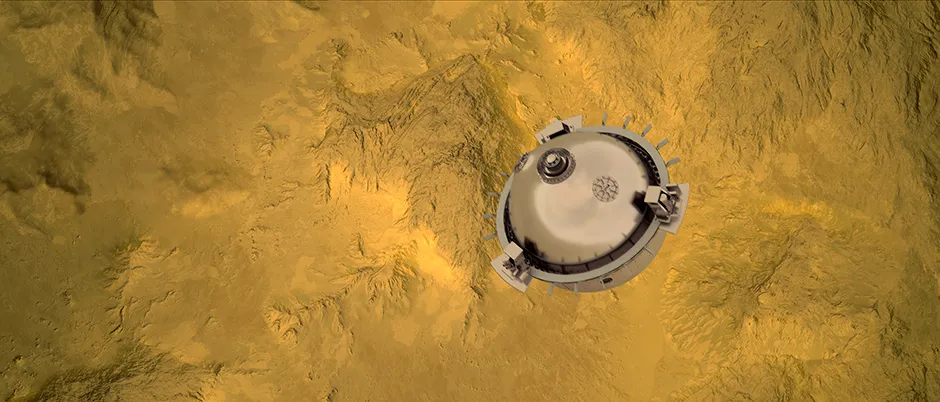It’s typical, you wait for one Venus mission and three show up at once: DAVINCI+ and Veritas sent by NASA and EnVision sent by ESA. Planetary scientist Paul Byrne reveals how these missions could help answer one of the biggest questions in science: is Earth unique?
We’re going back to Venus. Why’s that so exciting?
There’s two reasons. The first is that we haven’t done it in a while. When I say we, I mean the United States.
There is currently a probe at Venus. The Japanese space agency has the Akatsuki orbiter, which is a climate atmosphere focussed orbiter and it’s been operating there for at least five years. And there’s been probes sent by ESA that have studied Venus from orbit.
Venus used to be the poster child for planetary exploration. We were interested in it because it was a big, rocky world right next door. It’s closer to Earth than Mars. It takes less time to get there. And the optimal alignment for launches happen more frequently than they do for Mars.
And remember Venus isn’t like Earth or Mars. You can’t see the surface of Venus from space, because its thick atmosphere obscures the surface from visible wavelengths.
This means we’ve got some fundamental questions for Venus, ones that we’ve been asking for decades and ones that we’ve only just discovered. We’re now poised to put that right.
What’s the other reason?
In the last 10 years there’s been a growing focus on exoplanets – planets orbiting stars other than our own. Right now our capability to detect them is biased towards planets like Earth and Venus: rocky worlds that orbit close to their star. They’re simply easier to see since they pass their star more often. Plus, we’re fundamentally interested in understanding: are there other Earths out there? Are we unique?
Our ability to resolve the radius of a planet cannot distinguish between a planet like Venus and another like Earth right now. When you see a news story about an “Earth-like world” you might as well say Venus-like world. We can’t tell the difference. It raises a fundamental question. If we find Earth-sized worlds, can we make any reasonable guesses as to what its conditions are? Will we find oceans, trees and clouds or will we end up at a self-cleaning oven like Venus?

So why haven’t we gone back or gone in for a closer look?
I genuinely do not know why NASA in particular has not gone back. I have Thoughts (with a capital T). The fact that operating at the surface is extremely technically challenging is definitely part of it. It’s easier to do science on Mars and the Moon. You can land and operate on those for white a while, but you can’t on Venus.
But you can stay in Venus orbit no problem for as long as you like. And the only other place in Solar System that we know of right now that’s Earth-like in terms of temperature and pressure is about 55km up in the Venus atmosphere. As bad as it is on the ground, at that altitude it’s about one bar, and zero Celsius. You can put parka on. You could stand outside a gondola on an aerial platform, on an airship, and be safe.
In fact, the French flew two balloons on Venus at around that altitude with the Soviet Vega missions in ‘85. They operated for about two days in the Venus atmosphere. They were not much more than tech demonstration missions.
So I think there’s more to it than just the difficulty. The timing of it is interesting. In 1996 ALH84001 hits the scene. This was a meteorite picked up in Antarctica in 1984, later recognised to have come from Mars and it was potentially thought to have contained fossilised microbes from the Red Planet.
In the end the overwhelming scientific consensus was that these weren’t signs of alien life, but that moment immediately shifted the focus to Mars as a world that was potentially habitable and potentially inhabited. This happened at around the same time that Magellan mission that went to Venus came to an end, and it certainly didn’t help the Venus community retain currency. But there is no specific reason why Venus is less scientifically meritorious than Mars, and I think a lot of scientists would agree that Venus is actually more interesting.
Based on what we know then, what do we think the surface of Venus is like?
It’s about 470°C. And it’s nearly that temperature everywhere, from the poles to the equator. It’s all rubbish. You’re not going be set on fire, but you will bake. Venus is in a runaway greenhouse state. And if that doesn’t cook you, the atmosphere is 96.5 per cent CO2. So you’ll asphyxiate pretty fast. And then there’s the pressure. The atmospheric pressure at the surface is 90 times that of the room temperature. 90 bars. It’s the equivalent to being 1km under water on Earth.
Then there’s sulphuric acid rain. There’s a global cloud layer and those clouds are dominantly made of sulphuric acid. We don’t think it rains on the surface. It’s too hot. So we think there is some kind of precipitation from the bottom of the cloud layer down, but the rain never reaches the ground. You only have to deal with it when you travel through the clouds.
Other than all those things it’s fine.
If you want to land something, the main problem you’ll have is the electronics. The landers we’ve sent in the past will still be sitting there today. They might be weathered but they were titanium spheres – there’s no way they’re melted. But the electronics will have fried.
Read more about Venus:
- Did we find signs of alien life in the clouds of Venus? Here’s what the experts say
- Race to Venus: What we'll discover on Earth's toxic twin
- Could we live on airships in the atmosphere of Venus?
So what fundamental questions about Venus will these missions help us answer?
Why is it that a planet so similar in size, make-up, age and orbit to the Earth is so unlike Earth? You can almost frame everything into that umbrella. These missions won’t solve that, but it will help us address it.
We have two models for how Venus came to be. The first is that the planet was always terrible. It started off in what we call the magma ocean phase, which we think most rocky planets do.
The idea is that this early Venus was too close to the Sun to ever cool down long enough to condense the gasses in the atmosphere. In particular, H2O didn’t cool enough to form oceans that cover the ground and form crusts, and it ends up just holding onto a CO2 atmosphere. This means Venus enters a runaway greenhouse effect (it can’t lose as much heat as it’s gaining), and so the planet is ruined from the beginning. In which case the answer to why Venus is so weird is that it’s simply a function of how far away it is from the Sun. That’s it.
The second scenario is that Venus might actually have been just like Earth, with oceans and plate tectonics. One of the most interesting discoveries of Venus missions in the 70s and 80s was to do with something called the deuterium-hydrogen ratio [deuterium is an isotope of hydrogen].
On Venus we discovered that the ratio is about 100 times higher than that of Earth, and the best explanation for that is that at some point Venus might have had lots of water and now it’s gone. The surface is bone dry. Which means some event would have triggered this runaway greenhouse effect.
So how will these probes provide answers?
The DAVINCI+ mission will have an orbiter, but the star of the show is the probe which will descend to the planet over the course of an hour on a parachute. Then it will freefall from about 60km down towards the surface. It’s going to measure the deuterium-hydrogen ratio. Right now the error bar is pretty big on the measurements from the 70s and 80s. The deuterium-hydgrogen ratio will tell us how much water there was on Venus, but it won’t tell us what state it was in.
The water could have been a hot steam filling the atmosphere or that water could have been a cool liquid forming oceans on a balmy surface. To find that out we have to measure the noble gases present. The noble gases are our friends here: helium, argon, xenon, neon. They’re tied to different parts of the interior of the planet, and if we look at their concentration, we can build a model of what’s been ejected from the planet’s interior and get a picture of the history of Venus, and what state its water might have been in if it had it.
So if we work out which of the two scenarios is true for Venus we’ll have a better idea of just how unique Earth might be?
Here’s where it gets interesting. If we find out that it’s the first scenario, that it was always too hot, that makes things a bit easier. We can just look at a planet’s distance from the star and say: “OK, it’s in the Venus zone, it’s probably going to be ruined.” And then we can test that.
But if it’s scenario two, that has big implications. Recent work, led by Michael Way, who’s at the NASA Goddard Institute of Space Science, has built models that show that cloud layers could have kept Venus cool early on. After that point, the planet should have remained stable.
Clearly, something went wrong. And that is where the model suggests that something introduced a whole pile of CO2 into the air quickly, geologically speaking. The only process that we can think of that can do that is volcanoes. A lot of them. They put a lot of CO2 into the air. Not as much as humans, but if you have enough big eruptions over a geological short period of time it’s possible that you could dump enough CO2 into the atmosphere that you could trigger a climate change.
The whole point of this is to say we don’t what drives these events, we don’t know if they happen on a cycle or if they’re kind of random.
If scenario two is correct for Venus, then was it just unlucky to have a few volcanoes go off at the same time and go down this irrevocable path of climate change? Or is Earth lucky that it hasn’t happened here yet? Maybe Venus is the “normal” one and maybe Earth is unusual. Whatever we find on Venus is going to be important to make sense of our own planet’s history and future, but also what we’ll see around other stars.

Will we get a new sense what it’s like to stand on Venus?
The place they’ve picked to drop the probe is an area called Alpha Regio. It’s an area of land on Venus called a tessera. That’s not a geological term, it’s just what the Russians invented when they discovered this terrain. About 7 per cent of the surface of Venus seems to be covered in tesserae, which is a lot when you consider Venus has no oceans.
It seems to be tectonically formed: there’s lots of fractures cut through at different orientations as well as folds. But we don’t know what it is. It’s unlike anything else in the Solar System.
As DAVINCI+ drops to the surface and the haze clears it will take a series of images downwards at set altitudes. These will be the highest resolution images we’ve ever had, they’ll let us zoom in and out to understand the structure.
Meanwhile, Veritas will provide us with incredibly high-resolution radar data – up to 10m per pixel in place. It’ll be like comparing a computer game from the 80s with one from today. We’ll see things we didn’t even imagine were there on the surface of Venus. Veritas will give us a much better handle on the structure of Venus, the surface, the interior and even the core.
So what does the next decade look like for a planetary scientist like yourself?
These missions are game-changing. They’re the promise of a second golden age of Venus exploration.
Personally, I’m committed to playing my part to make sure that these are not the only two missions that NASA decides to send the Venus the next 30 years. These two missions will not answer all the questions.
However, when DAVINCI+ reaches its final destination, the tessera, it could effectively be looking at a future landing site. It just so happens that there’s new research showing that it’s possible to build circuit connections, transistors and cables, out of silicon carbide, which can function happily at Venus temperatures. So we could see a station that could sit on the surface for 60-120 days, that would actually able to test a sample taken from the surface of Venus.
Read more about space exploration:
- James Webb Space Telescope: Inside the high-stakes testing of Hubble’s £7.2bn successor
- Inside the mission to spot an alien city by harnessing the Sun’s colossal gravity
- How humanity will return to the Moon: The future of lunar exploration
About our expert, Paul Byrne
Paul is an associate professor of Planetary Science at North Carolina State University. His work involves using remotely sensed data, modelling, and lab and field work to undertand how planets form and evolve. He’s also Venus’s biggest cheerleader on Twitter right now, where you can find him tweeting about everything to do with space exploration @ThePlanetaryGuy.
